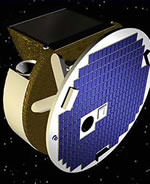
Image credit: CSA
Everything is ready to go for the launch of the Canadian Space Agency’s Scientific Satellite Atmospheric Chemistry Experiment (SCISAT-1) on board a Pegasus XL rocket on Wednesday, August 13. If it all goes as planned, the L-1011 aircraft will carry the Pegasus rocket over the Pacific Ocean, and release it at 0210 GMT (10:10 pm EDT Tuesday) to carry SCISAT into orbit. SCISAT will help scientists track the chemical processes that control the distribution of ozone in the Earth’s atmosphere.
The Canadian Space Agency’s Scientific Satellite Atmospheric Chemistry Experiment (SCISAT-1) is scheduled to launch on Tuesday, August 12, between 10:05 and 11:02 p.m. EDT.
An L-1011 jet aircraft departing from Vandenberg Air Force Base (VAFB), Calif., will carry the Pegasus XL vehicle that will launch SCISAT-1. The L-1011 will drop the Pegasus, and its 330-pound spacecraft, over the Pacific Ocean at approximately 10:10 p.m. EDT. The SCISAT-1 mission will provide scientists with improved measurements of the chemical processes that control the distribution of ozone in Earth’s atmosphere.
The pre-launch press conference is at the NASA Resident Office at VAFB, Monday, August 11, at 4 p.m. EDT. The press conference will be carried live on NASA TV with question and answer capability available from NASA Headquarters; KSC; and Goddard Space Flight Center, Greenbelt, Md.
On launch day, media should meet at the VAFB main gate at 8:30 p.m. EDT to be escorted to the runway for the L-1011 take-off. Media may follow the release and launch of Pegasus/SCISAT from the viewing room of the NASA Mission Director’s Center, Building 840 on South VAFB.
Assuming a nominal flight of the Pegasus launch vehicle, a post-launch news conference will not be held. However, launch vehicle and spacecraft representatives will be available afterward to informally answer questions from the media.
Launch coverage on NASA Television begins at 8:30 p.m. EDT through spacecraft separation from the Pegasus vehicle. NASA TV is broadcast on AMC-9, Transponder 9C, C-band, located at 85 degrees west longitude. The frequency is 3880.0 MHz. Polarization is vertical, and audio is monaural at 6.80 MHz. Live launch commentary and audio of the Pegasus/SCISAT briefing will be available on the “V” audio circuits available at: 321/867-1220/1240/1260/7135.
The Pegasus/SCISAT News Center at the NASA VAFB Resident Office will be staffed starting on Monday from 11 a.m. to 7:30 p.m. EDT; phone: 805/605-3051/3001. A recorded status report is available at: 805/734-2693.
Click the “Watch NASA TV Now!” link for live Web cast at:
http://www.nasa.gov
NASA’s Earth Science Enterprise sponsors the mission and is responsible for countdown and launch management. Orbital Sciences Corp. will provide the launch service, and the Canadian Space Agency is responsible for spacecraft development.
Original Source: NASA News Release
